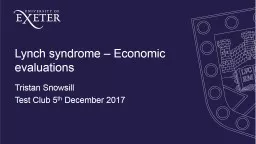

Tristan Snowsill Test Club 5 th December 2017 Lynch syndrome Heritable cancer syndrome Heritable Caused by constitutional mutations affecting the DNA mismatch repair genes MLH1 MSH2 ID: 931277
Download Presentation The PPT/PDF document "Lynch syndrome – Economic evaluations" is the property of its rightful owner. Permission is granted to download and print the materials on this web site for personal, non-commercial use only, and to display it on your personal computer provided you do not modify the materials and that you retain all copyright notices contained in the materials. By downloading content from our website, you accept the terms of this agreement.
Slide1
Lynch syndrome – Economic evaluations
Tristan Snowsill
Test Club 5
th
December 2017
Slide2Lynch syndrome
Heritable
cancer syndrome
HeritableCaused by constitutional mutations affecting the DNA mismatch repair genes MLH1, MSH2, MSH6 and PMS2Autosomal dominant pattern of inheritanceIncomplete penetrance
Cancer syndrome
Carriers at increased risk of
Colorectal cancer
Endometrial cancer
Ovarian cancer
Plus others (gastric cancer, small bowel, …)
Cancer incidence at earlier age than gen. pop.
No premalignant signs of Lynch syndrome
Slide3Lynch syndrome
Population prevalence (≈ incidence at birth)
Around 1 in 400
Estimated to cause
≈ 3% of colorectal cancer and endometrial cancerDisproportionately responsible for early-onset cancer (up to 8%)Cancer survival tends to be somewhat better than sporadic cancer
Slide4Interventions
Surveillance
Risk-reducing surgery
Chemoprevention
Slide5Diagnosis (affected by CRC/EC)
Limited use
Clinical and pathological features
Family history
Suggestive, but not diagnosticMicrosatellite instability (MSI) testingMMR immunohistochemistry (IHC)Excluding likely sporadic casesMLH1 methylation testingBRAF V600E mutation testing (CRC only)
Slide6Diagnosis (affected by CRC/EC)
Diagnosis through identification of pathogenic constitutional mutation in or affecting MMR genes
Sequencing for short mutations
MLPA for genomic mutations (deletion, inversion, repetition of exons)Interpretation can be challenging
Slide7Predictive testing
When a Lynch syndrome mutation is known in the family, can test blood relatives for mutation
Very accurate
Not very expensiveUsually use cascade testing
Slide8Genetic counselling
Usually individuals are referred for genetic counselling prior to mutation testing
Helps them to understand
What is being tested for
What the risks areWhat options are availableCounselling also recommended following testingBut some suggest substantial streamlining
Slide9(How) should we try to identify people with Lynch syndrome?
Two broad routes to diagnosis in a previously unidentified family
Referred after being affected by cancer (possibly reflex)
Referred due to strong family history of cancer
Population screening (with or without risk assessment) unlikely to be cost-effective compared to reflex or opportunistic testing
Slide10Decision problems
Criteria
PenTAG
HTA report 2014
PenTAG NICE DAR 2016Current workPopulationEarly-onset CRCCRC (all ages)EC (subgroup by age)
Tests
IHC, MSI,
BRAF
,
MLH1
methylation
IHC, MSI,
BRAF
,
MLH1
methylation
IHC, MSI,
MLH1
methylation
Risk-reducing interventions
Colonoscopies
Risk-reducing surgery
Colonoscopies
Risk-reducing
surgery
Gynae
s
urveillance
Aspirin
Colonoscopies
Outcomes
Incremental cost-effectiveness ratio (ICER)
Costs
QALYs
Study design
Economic
model (individual patient sampling)
Economic model (Markov cohort)
Slide11Model structure
Decision tree for affected individual
Leads to:
Lynch syndrome diagnosed
Lynch syndrome assumedAssumed sporadicThen individual patient sampling or Markov model used to predict long-term outcomesIf Lynch syndrome diagnosed then predictive testing offered to relativesIf Lynch syndrome assumed then relatives may be offered surveillance
Slide12Summary of findings
PenTAG
HTA report 2014
Life expectancy for those with Lynch syndrome improved by over 1 yearIncreased use of colonoscopiesDecreased CRC incidence and mortality
All testing strategies cost-effective versus no testingIn fully incremental analysis MSI with BRAF was cost-effectiveIncreasing age threshold worsens cost-effectiveness
Slide13Summary of findings
PenTAG
NICE DAR 2016
Testing still cost-effective versus no testing (except for direct mutation testing)Cost-effective strategy is IHC plus BRAF
and MLH1 methylation testing
Slide14Current work
Cost-effectiveness of different testing strategies to identify Lynch syndrome in women with endometrial cancer
Pragmatic literature reviews for model parameters
Sophisticated(?) meta-analyses and parametric model fittingDecision tree and Markov model
Extensive exploration of uncertainty
Slide15Tests with more than two outcomes
Microsatellite instability testing
Typically use panel of 5 markers
0 affected
Microsatellite stable (MSS)1 affected Low microsatellite instability (MSI-L)2-5 affected High microsatellite instability (MSI-H)MMR immunohistochemistryPanel of four antibodies for MMR proteinsAbsent/weak/abnormal staining suggests deficiency in MMR systemBUT MSH6/PMS2 proteins break down if they cannot dimerize with MSH2/MLH1Intention to diagnose?
Slide16Intention to diagnose
If individual has following pattern of IHC staining:
MLH1 absent
MSH2, MSH6 and PMS2 present
Is it a true positive result if the individual actually has an MSH2 mutation?What are the likely downstream tests?
Slide17Bivariate meta-analysis
MSI testing
MMR immunohistochemistry
Slide18Test failure
What are thresholds for considering tests to have failed?
MSI
Any markers non-evaluable?
No markers evaluable?IHCAny proteins non-evaluable?MSH6/PMS2 non-evaluable?
Slide19Prevalence of Lynch syndrome
Assume age of cancer onset is Normally distributed given LS status:
For each study we have an age limit
and by Bayes’ rule we can relate the observed prevalence
to the counterfactual prevalence in an unselected cohort with the Bayes’ rule:
We fit a random effects model for the log-odds prevalence of LS:
This is all fitted using the Stata
ml
suite
Slide20Gene distribution of LS in EC patients
Variation due to random chance or heterogeneity across studies?
Slide21Incidence of colorectal cancer (fitting)
Slide22Cumulative risk of colorectal cancer
Slide23Plans
Current work
Manuscript drafted by Christmas/New Year
Send to people who may be interested in being co-authors or “internal reviewers” (former collaborators)Submit to journal (TBD) by end of February 2018
Next stepsCollaborate with Neil Ryan, Emma Crosbie, Katherine Payne in Manchester to integrate with their analyses based on PETALS study
Slide24Thank you!
Any questions?